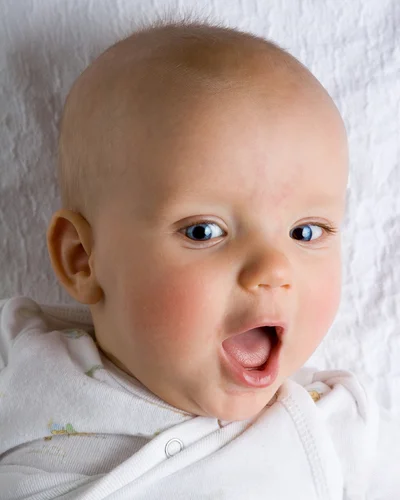Language Development: the study of the acquisition of language in human young. (Cardwell, 138) The key task in the development of language is to learn a set of grammatical rules that allow the child to produce an unlimited number of sentences from a limited number of words. (Hockenbury, 362)
By the time a child reaches 3 years of age, he or she will have learned approximately 3,000 words and the complex rules of their language. Acquiring about a dozen new words per day, a child may have a “production vocabulary” of more than 10,000 words by school age. (Hockenbury, 365) The first sign of “language” is usually a “gesture” which infants will make at about ten months. The best way to think about this process is that it begins with a one-element stage, and that element may be a word or a gesture, such as pointing. Gesture and speech combinations increase between fourteen and twenty-two months. Children also show a three-element stage using both gesture and speech before producing three elements in speech alone. Following this stage, speech starts to emerge as the prime method of communication. (Kenneally, 133-134)
Babbling: the adding of consonants to the vowels and stringing the sounds together in sometimes long-winded productions, such as ba-ba-ba-ba, de-de-de-de, or ma-ma-ma-ma. Begins about 5 months of age. Infants all over the world use the same sounds when they babble, including sounds that do not occur in the language of their parents or other caregivers. At around 9 months of age, babies begin to babble more in the sounds specific to their language. (Hockenbury, 364)
Cooing: repeating vowel sounds such as ahhhh or ooooo, varying the pitch up or down. Begins around 3 months of age. (Hockenbury, 364)
One-Word Stage: first spoken words often made up of the syllables that were used in babbling. Usually refer to concrete objects or people that are important to the child. Begins somewhere around their first birthday. (Hockenbury, 364)
Motherease: a style of speech used by people in every culture with babies. Characterized by very distinct pronunciation, a simplified vocabulary, short sentences, high pitch, and exaggerated intonation and expression. Content is restricted to topics that are familiar to the child. Questions are often asked, encouraging a response from the infant. (Hockenbury, 362) Also referred to as ‘infant-directed speech.’
Two-Word Stage: combining two words to construct a simple "sentence" such as "mama go," "where kitty?," and "no nap!" Begins around 2.0 years of age. (Hockenbury, 365)
